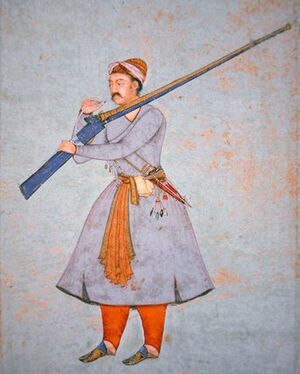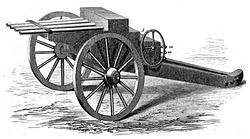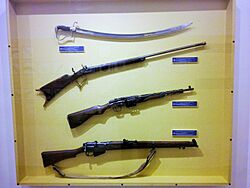History of the firearm facts for kids
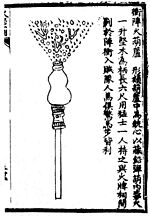
The history of firearms began in China around the 10th century. Early firearms were tubes filled with gunpowder and small metal balls, attached to spears. These were called fire lances and could be used by one person. They were first used as a surprise weapon in the Siege of De'an in 1132.
Later, in the 13th century, these fire lances got metal barrels and became hand cannons. This new technology slowly spread across Eurasia during the 14th century. Over time, hand cannons developed into different types of guns like flintlocks and blunderbusses.
The 19th and 20th centuries saw even faster changes. Guns got magazines to hold more bullets, and some could fire automatically. Modern firearms use smokeless powder instead of older black powder. Most also have rifled barrels, which means grooves inside the barrel that make the bullet spin and fly more accurately.
Contents
Early Firearms in China
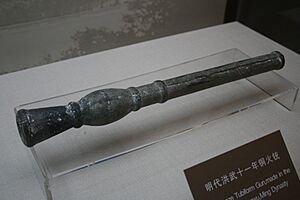
The fire lance was a tube filled with black powder, attached to a spear. It was used like a flamethrower. Sometimes, small pieces of metal, like shrapnel, were added to the barrel to fly out with the flames. The oldest known drawing of a gunpowder weapon is a fire-lance on a silk banner from Dunhuang, dating back to the mid-10th century. Records from the siege of De'an in 1132 show that Song soldiers used fire-lances against the Jurchen invaders.
To make these weapons more powerful, the amount of saltpeter in the gunpowder was increased. To handle this stronger blast, the paper and bamboo barrels of fire-lances were replaced with metal. Also, the shrapnel was replaced with single projectiles that fit the barrel better. This is how the basic gun was born: a metal barrel, powerful gunpowder, and a fitted projectile.
The oldest picture of a gun is a sculpture from a cave in Sichuan, from the 12th century. It shows a Chinese person holding a vase-shaped gun, with flames and a cannonball coming out. The oldest real firearm still existing is the Heilongjiang hand cannon, found in Acheng District. It dates back to 1288. History books say that a military leader named Li Ting used hand cannons in battles around that time.
Firearms in the Middle East
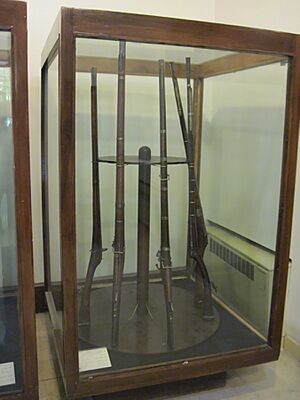
Firearms appeared in the Middle East between the late 13th and early 14th centuries. Some historians believe that gunpowder was introduced by the invading Mongols.
The first mentions of what might have been arquebuses (early handheld guns) by the Janissary soldiers of the Ottoman army date from 1394 to 1465. It's not fully clear if these were true handheld firearms or small cannons at first. However, by the mid-15th century, they were listed separately from cannons, suggesting they were handheld.
The musket, a heavier type of handheld gun, first appeared in the Ottoman Empire by 1465. A Chinese book about firearms from 1598, called Shen Qi Pu, described Turkish muskets as better than European ones. Before 1598, the Turks developed a special matchlock firing system. This system was later improved by Chinese designers to make guns more reliable, especially in bad weather.
Firearms in Southeast Asia
People in the Nusantara archipelago (Southeast Asia) knew about gunpowder weapons after the failed Mongol invasion of Java in 1293. Early pole guns were recorded in Java in 1413. However, the knowledge of making "true" firearms came later, after the mid-15th century. It was likely brought by Arab traders around 1460. Before the Portuguese arrived, simple firearms like the Java arquebus were already present.
Gun technology improved further after the Portuguese captured Malacca in 1511. From 1513 onwards, German-Bohemian and Turkish gun-making styles combined. This led to a new style of matchlocks in India and Portugal. Indian gun makers changed the design, making the guns lighter and more balanced, with a short stock held against the cheek. The Portuguese, who fought a lot on ships, liked these more compact guns. Malay gun makers quickly learned these new techniques and created a new type of arquebus called the istinggar.
Firearms in South Asia
The first recorded use of firearms in South Asia was at the Battle of Adoni in 1368. The Bahmani sultanate used artillery against the Vijayanagara Empire. When the Portuguese arrived in India in 1498, they brought firearms like the matchlock musket and warships armed with cannons. Portuguese travelers noticed that firearms were already being used there. Local blacksmiths made simple handguns for people in the Gangetic plains. Places like Travancore, Kashmir, Rajasthan, Punjab and Sindh were centers for making weapons.
In the early 16th century, Babur, the first Mughal emperor, brought Turkish firearms to India. These were used against the Delhi Sultanate in the First Battle of Panipat. The Rajputs and Afghans then also started using them. Throughout the 16th and 17th centuries, firearms were very important in the Mughal army. Mughal emperor Akbar made many improvements to the matchlock, known as the tufang. However, until the 18th century, firearms took longer to load and were sometimes less effective than longbows.
Later, the Marathas also developed firearms. During the 18th century, Tipu Sultan was famous for using guns, mortars, rockets, and howitzers very well.
Firearms in Europe
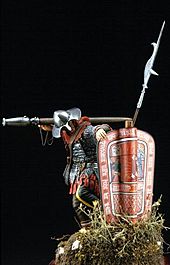
There are different ideas about how gunpowder came to Europe. One idea is that it traveled along the Silk Road. Another is that it arrived during the Mongol invasion in the early 13th century. English records from the 1340s mention ribaldis, which were early cannons. Siege guns were used by the English at the Siege of Calais (1346–47).
The first mention of firearms in Russia is from 1382. It says that during the defense of Moscow from the Golden Horde, Muscovites used firearms called tyufyaki, which came from the East.
Around the late 14th century in Italy, smaller, portable hand-cannons called schioppi were developed. These were the first personal firearms with a smooth barrel. The oldest surviving firearm in Europe was found in Otepää, Estonia, and dates back to at least 1396.
Firearms changed a lot during the Hussite Wars (1419-1434). The Hussite army was mostly made up of regular people who didn't have the same skills or weapons as the professional Crusader armies they fought. The Hussites were pioneers in using firearms on the battlefield, often with war wagons. At first, firearms were used to help in battles, but by the 1421 Battle of Kutná Hora, they became main offensive weapons. The Hussite militia used several types of handheld firearms, including the píšťala, which later gave us the word pistol.
By the late 15th century, the Ottoman Empire regularly used firearms in its army. Early Turkish hand cannons were called Şakaloz.
Modern Firearms Begin
During the early modern age, handheld cannons developed into different types of rifles, like the matchlock, wheellock, and flintlock. Later came the breech loader and then the automatic weapon. Different ways to ignite the gunpowder were used over time, including matchlocks, flintlocks, and percussion caps. The paper cartridge, which combined the bullet and powder, appeared before 1586. The bayonet, a knife attached to the end of a rifle, came into use in 16th century France. Hand grenades, thrown by soldiers called grenadiers, also appeared around this time.
Early cartridge firearms needed to be prepared before each shot. When the trigger was pulled, a hammer would strike a "firing pin." This pin would hit a "primer," a small cap with a chemical that would ignite. This flame would then go through a "flash hole" into the cartridge, setting off the gunpowder.
The Springfield Armory in Massachusetts became important in the 1850s. They introduced the Springfield rifle, which was one of the first rifles that could be loaded from the back (breech-loading). By this time, metalworking had improved enough to make brass ammunition cases. Before this, each bullet was made by hand: soldiers poured loose powder down the barrel, added a wad, and then pushed a bullet on top with a ramrod. This was slow and not always reliable.
Fixed ammunition changed this. It combined the primer, a measured amount of powder, and the bullet into one waterproof brass cartridge case. The soft brass would expand when fired, sealing the back of the barrel. This stopped hot gases from escaping and hurting the shooter.
Guns That Fire Many Shots
A repeating firearm, or "repeater," can hold many bullets and fire multiple times before needing to be reloaded. These guns have different ways of getting a new bullet ready to fire. This usually means taking out the used cartridge and moving a new one into the firing chamber. Examples include bolt-action, lever-action, slide-action, semi-automatic, and fully-automatic firearms. Automatic weapons reload themselves after each shot. Semi-automatic guns fire one shot each time you pull the trigger. Fully automatic guns fire many shots as long as you hold the trigger.
Revolvers
Revolvers hold bullets in a spinning cylinder. This cylinder acts as both the place where bullets are stored and where they are fired. They were the first type of repeating guns. Early revolvers, like the Colt Paterson from 1836, were "single action." This meant you had to pull back the hammer by hand before each shot. "Double-action" revolvers came out around the same time. You could fire them by pulling back the hammer, or just by pulling the trigger.
Self-Loading and Machine Guns
The first successful self-loading gun was the Gatling gun. It was operated by a hand crank and used by Union forces during the American Civil War. Self-loading guns use the energy from firing a shot to reload the next one. The world's first true machine gun was the Maxim gun, invented by Sir Hiram Maxim in 1884.
The first successful self-loading rifle that could be used by one person was the Mondragón rifle, designed in 1908 by Mexican general Manuel Mondragón. It was used during the Mexican Revolution and World War I.
The first submachine gun, which fires pistol bullets and can be used by one soldier, was the MP18.1. It was introduced in 1918 by the German Army for special assault groups. During World War II, well-made submachine guns like the Thompson were replaced by simpler, mass-produced ones like the M3.
The first successful assault rifle was the StG 44, introduced by the Germans during World War II. It was a new type of gun that was more powerful and had a longer range than a submachine gun, but was lighter and had a shorter range than standard rifles. It used medium-sized bullets and could switch between firing single shots or fully automatic. The AK-47, also known as the "Kalashnikov," is the most widely made assault rifle in the world.
See also
 In Spanish: Historia de las armas de fuego para niños
In Spanish: Historia de las armas de fuego para niños
- Science and technology of the Song dynasty
- Jiao Yu
- Huolongjing
- History of cannon
- History of weapons
- Military history
- Table of handgun and rifle cartridges
- Gunpowder artillery in the Song dynasty





